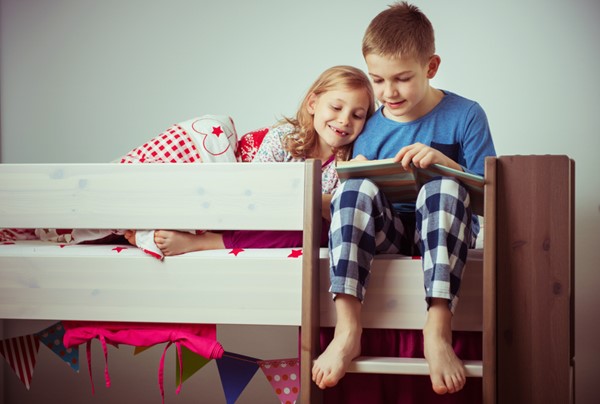
If you’re like many families, you never seem to have quite enough space for each family member to spread out. To stay within your budget, or maybe to create a more close-knit family you have two or more children sharing a room. As time goes on sharing personal space can create rifts between siblings. To avoid added stress and tension consider employing some shared space solutions to help your family members establish their own space, even in a shared room. Here are some divided ideas to get you started.
Mirroring setup – A simple solution is to just split the room right down the middle. Create mirroring layouts on either side of a shared dresser or desk-space and allow each child to spread out on their half.
Curtain Wall — You can also divide the room with an actual curtain or screen. A weighted curtain hanging through the center serves as a visual barrier and helps create a sound barrier as well.
Lofted bed — Purchase a pair of lofted beds with built-in desk space underneath. Each child can build out their area and have a place to go that is entirely their own. As children age, you can even install curtains across the bottom of the loft to give them more privacy.
Divide the closet — Children commonly fight about a sibling's belongings finding their way into their space. This issue is especially true when it comes to closet space. Make sure you establish a separation of closet and storage space (and bathroom if they're sharing one) to help your kids protect their belongings and feel that their stuff is indeed theirs.
Wireless Headphones — Without purchasing furniture or shelving, you can give your kids a sense of personal space by merely providing them with a way to block out the activities of other family members. Get each of your children a pair of wireless headphones so they can enjoy their music, audio-book or phone entertainment without disturbing each other.
Hold Children Accountable for their space. Separately. — Your daughters might share a room, but both may not be equally at fault for the clutter or lack of cleanliness. A benefit of delineating a separation between their spaces is that it helps you see what each of them is doing, individually. Hold the messy child responsible for their half of the room and positively reinforce the child who is completing their chores.
Though they might think it so, children to do not need their own rooms to be happy. Learning to share smaller spaces can help your family grow closer. You have to learn more about each other, pay attention to preferences and pet peeves and generally learn to give and take on a more regular basis. Start your kids on the right path to personal growth and family unity by establishing their individual areas and responsibility versus shared family space.
About the Author
